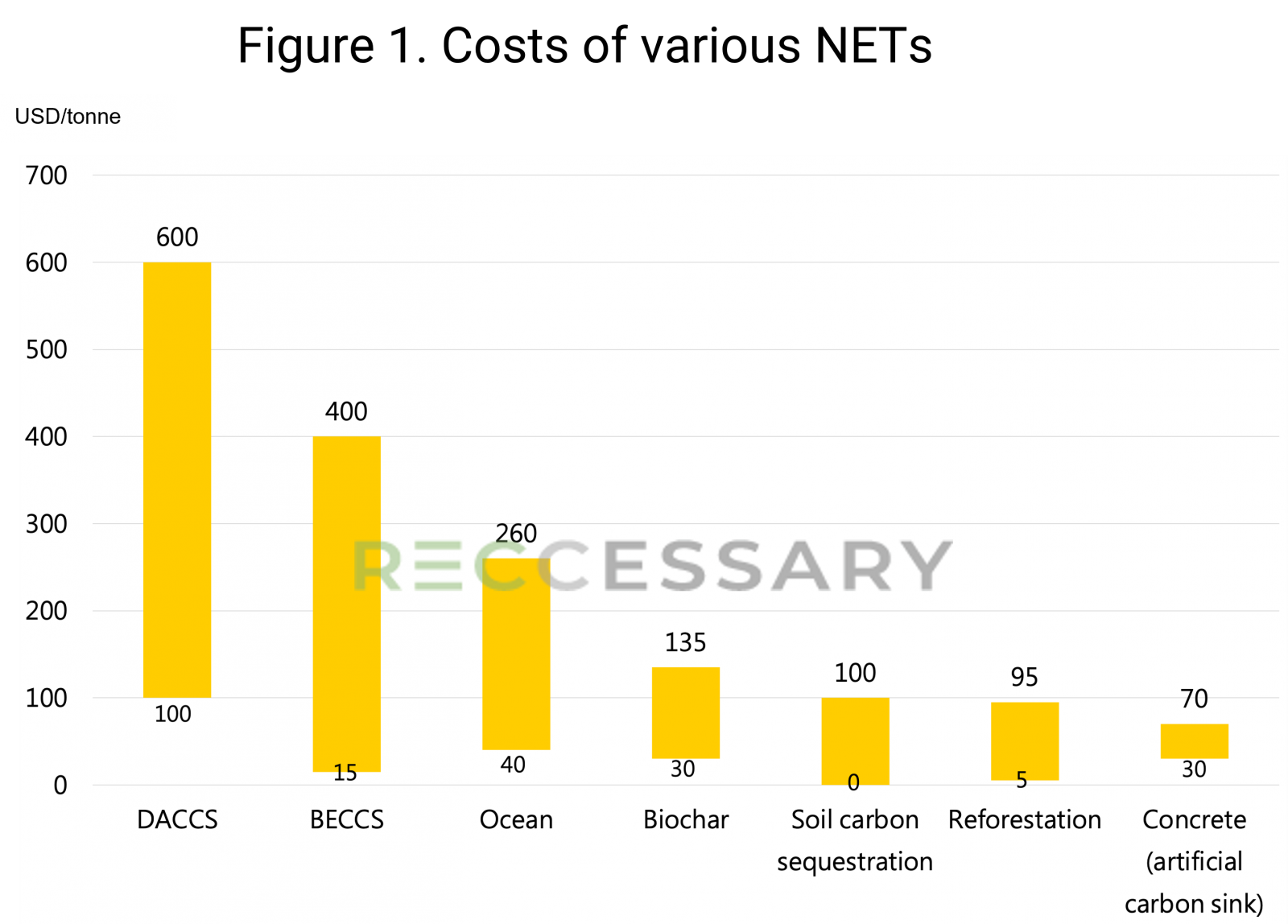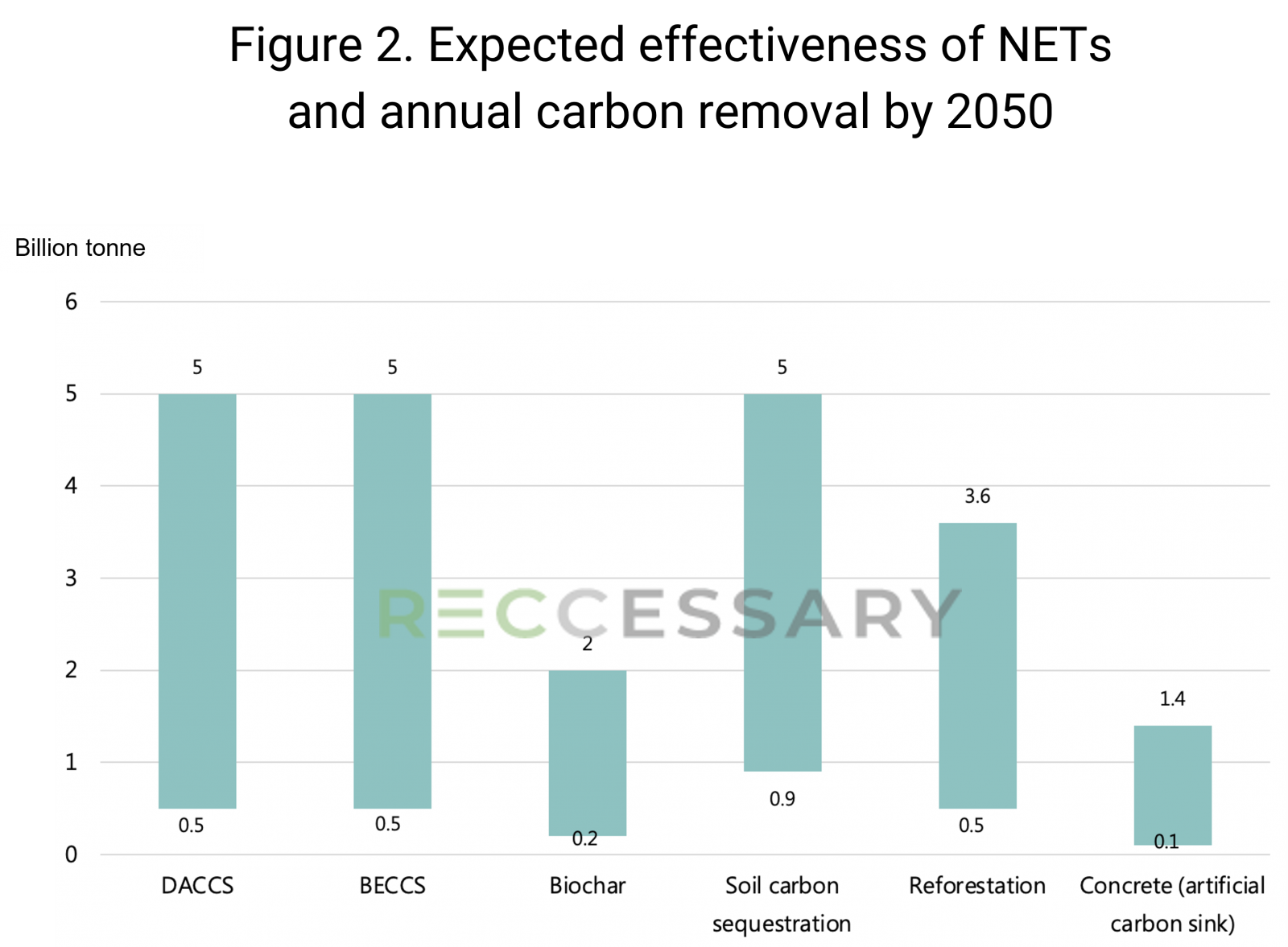According to the Intergovernmental Panel on Climate Change (IPCC), global warming must be limited to 1.5°C by 2030 to avoid climate disasters. One way to achieve this goal is adopting Negative Emissions Technologies (NETs), which can reduce the concentration of carbon dioxide in the atmosphere by removing more carbon dioxide than is emitted by humans to offset unavoidable carbon emissions from everyday life and business activities. There are three approaches to this technology:
- Natural carbon sink: Refers to areas in the natural environment that can absorb and store carbon dioxide, including forests, oceans, soils, etc. The development of forest carbon sequestration is relatively mature and has well-established measurement methodologies, while soil carbon sequestration is the least developed due to insufficient methodologies and related research.
- Artificial carbon sink: Refers to products or specific materials that can be used to store carbon dioxide. For example, wood used as a building material.
- DACCS or BECCS: Direct air capture with carbon storage (DACCS) is a technology using chemical or physical processes[1] to capture and separate carbon dioxide directly from the air, while bioenergy with carbon capture and storage (BECCS) involves capturing carbon released from burning wood chips, crops, etc., and its sequestration underground.
Although fewer companies are willing to invest in these NETs due to their incomplete development, businesses should acknowledge their roles as important stepping stones to achieving net zero, especially as Carbon Capture, Storage, and Utilization (CCUS) offers a relatively cost-effective solution for carbon-intensive industries such as cement and steel.
Challenges in NET development
While NETs offer a pathway for countries and companies to attain carbon neutrality or even net zero, there are two major challenges to address. The first is the high cost, as illustrated in Figure 1 below. Despite the potential for significant cost reductions as the market and technology progress, NETs are still unable to compete with wind and solar power generation in terms of cost. Additionally, while supported by various carbon pricing schemes, such as the EU Emissions Trading System (ETS), which at one point reached EUR 100 per tonne, NETs are still less economically viable. Due to the lack of cost competitiveness and uncertainty regarding their effectiveness, the adoption of NETs remains slow.
The second challenge is the need for a large amount of land and water. With global carbon emissions reaching more than 40 billion tonnes per year, the absorption of one billion tonnes of carbon dioxide requires approximately 400,000 square kilometers of land using BECCS. On the other hand, the acquisition of biofuels requires massive land for growing crops, which may lead to deforestation and destruction of wildlife habitats, defeating the original purpose of environmental protection. Additionally, the significant amount of water and fertilizers required for crop cultivation places additional burden on already limited resources. Apart from BECCS, natural carbon sinks (such as reforestation) also necessitate extensive land, representing an insurmountable challenge for many companies and countries to overcome.
Figure 1. Costs of various NETs[2]

Effectiveness of negative emissions technologies
Despite the high cost and implementation difficulties for most companies, the carbon removal capability of NETs, if developed successfully, will be significant. As shown in Figure 2 below, DACCS and BECCS could potentially remove 5 billion tonnes of carbon dioxide per year, equivalent to 10% to 15% of global emissions.
Figure 2. Expected effectiveness of NETs and annual carbon removal by 2050[3]

While 160 million tonnes of carbon dioxide can be removed through existing NETs, the world need to remove at least another 350 million tonnes by 2025 to achieve the 1.5°C target. This huge demand, coupled with policy support, has encouraged an increasing number of enterprises to invest in the development of NETs, such as Carbon Engineering and Climeworks, both globally renowned carbon capture companies funded by Bill Gates.
NET application by businesses
NETs are particularly suitable for certain industries, as their costs can be significantly lower, such as in cement production. For instance, Taiwan Cement (TCC) employs calcium looping technology, using limestone, the raw material for cement, as an absorbent to capture carbon emissions during the combustion process. Aside from its cost-effectiveness, the stored high-purity carbon dioxide can be used to cultivate microalgae, an ingredient in skincare products, providing greater economic benefits than general chemistry-based carbon capture methods.
Not all industries are suitable for NETs due to cost and natural resource constraints. Despite their strong carbon reducing effects, companies should assess the characteristics of their own industries or explore partnerships to achieve cost-effectiveness.
[1] Chemical methods such as using potassium hydroxide solution; physical methods such as using fans.
[2] Data sourced from the International Energy Agency (IEA) and the Intergovernmental Panel on Climate Change (IPCC).
[3] Data were compiled from IPCC, Carbon Brief, and American University, Washington, D.C., for a comprehensive distribution.